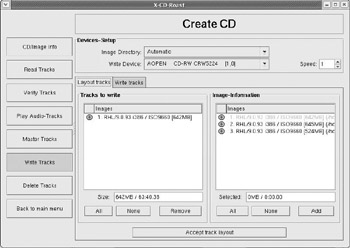Burning ISO Images to Disk
|
| < Day Day Up > |
|
When you download Fedora Core or other Linux distributions from the Internet, you usually download them in the form of one or more disk images, which are commonly referred to as ISOs because such files end in the .iso extension. An ISO is an image of a CD’s file contents, which means that it is the CD minus the media itself. To put it another way, if CDs had souls, the ISO would be the soul of a CD; take away the CD’s metal and plastic, and the remaining data would be an ISO.
As it is impossible to physically download a CD over the Net, the bodyless ISOs are the next best thing. For example, to get a working copy of Fedora Core from the Net, you need to download three ISOs, each which you can then burn onto a blank CD in order to give the images their bodies back, so to speak. In the process you thus create the three working installation disks that you need to install Fedora.
X-CD-Roast is the program of choice, my choice anyway, for burning (or duplicating) ISOs. The process is similar to that for duplicating CDs, albeit a bit simpler, as you already have a virtual CD, the ISO you downloaded, on your hard disk.
To start off, run X-CD-Roast as in the previous section and, assuming you have already gone through the setup process, click the Create CD button in the main window (shown in Figure 7-6 on page 106).
Once in the Create CD window, click the Write Tracks button, and you will be in the Write Tracks page of the Create CD window (see Figure 7-8). Click the Layout tracks tab, and in the Image Information pane you will see a list of all of the ISOs that are present in your CD_stuff folder (or whatever other folder you specified during setup). Click the ISO that you want to copy to disk, and then click Add. The ISO you selected will then appear in the Tracks to Write pane, and you can click the Accept Track Layout button at the bottom of the page. Then click the Write Tracks tab.

Figure 7-8: Selecting an ISO to burn to CD in X-CD-Roast
In the Write Tracks tab, the ISO that you selected should appear in the white pane. If so, adjust the write speed in the Speed box so that it is less than the maximum write speed for your drive; I personally find it better to limit the speed to about 8 when creating Linux installation CDs, as CDs written at faster speeds sometimes create installation headaches.
Once you’ve done that, click the Write Tracks button at the bottom of the page, and you will be prompted to put a blank CD in your drive. Do that, and then click OK. The write process will then begin.
As ISOs are usually quite large, the process will take a bit of time, so you will have to be a little patient. When it is all finished, X-CD-Roast will automatically eject your CD, and you can then close the remaining windows.
|
| < Day Day Up > |
|
EAN: 2147483647
Pages: 188